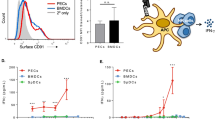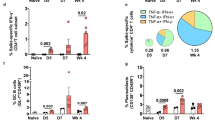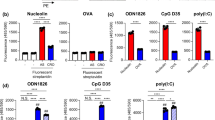Abstract
We have shown that Hsp60sp-loaded immature dendritic cells (DC/sp) can protect mice from the induction of experimental allergic encephalomyelitis (EAE) by inducing Qa-1-restricted CD8+ T regulatory (Treg) cells. The binding half-life between Qa-1 and Hsp60sp is particularly short and leads to an unstable Qa-1/peptide complex that significantly decreases the efficacy of this vaccination. To prevent Qa-1/Hsp60sp complex dissociation, we utilized paraformaldehyde (PFA) fixation to stabilize the formation of the Qa-1/Hsp60sp complex and maximize the function of DC/sp as a vaccine to control autoimmune diseases. Compared with the non-fixed DC/sp, the fixed DC/sp (FDC/sp) showed an enhanced ability to activate Qa-1-restricted Hsp60sp-specific CD8+T cells in vitro and prevented EAE in vivo. Importantly, the FDC/sp maintained immune activity following cryopreservation for 1 week or after storage for 72 h at 4 °C. These results indicate that PFA fixation can sustain or increase the efficacy of DC/sp by improving the stability of the Qa-1/Hsp60sp complex on the surface of the DC/sp. In addition, PFA fixation creates a time window for DC/sp storage, transport and application. Our data suggest a potential clinical use of FDC/sp as a vaccine for the prevention and treatment of autoimmune disease.
This is a preview of subscription content, access via your institution
Access options
Subscribe to this journal
Receive 12 digital issues and online access to articles
$119.00 per year
only $9.92 per issue
Buy this article
- Purchase on Springer Link
- Instant access to full article PDF
Prices may be subject to local taxes which are calculated during checkout




Similar content being viewed by others
References
Michaelsson J, Teixeira de Matos C, Achour A, Lanier LL, Karre K, Soderstrom K . A signal peptide derived from hsp60 binds HLA-E and interferes with CD94/NKG2A recognition. J Exp Med 2002; 196: 1403–1414.
Davies A, Kalb S, Liang B, Aldrich CJ, Lemonnier FA, Jiang H et al. A peptide from heat shock protein 60 is the dominant peptide bound to Qa-1 in the absence of the MHC class Ia leader sequence peptide Qdm. J Immunol 2003; 170: 5027–5033.
Chen W, Zhang L, Liang B, Saenger Y, Li J, Chess L et al. Perceiving the avidity of T cell activation can be translated into peripheral T cell regulation. Proc Natl Acad Sci USA 2007; 104: 20472–20477.
Wu Y, Zheng Z, Jiang Y, Chess L, Jiang H . The specificity of T cell regulation that enables self-nonself discrimination in the periphery. Proc Natl Acad Sci USA 2009; 106: 534–539.
Lu Y, Chen B, Song JH, Zhen T, Wang BY, Li X et al. Eriocalyxin B ameliorates experimental autoimmune encephalomyelitis by suppressing Th1 and Th17 cells. Proc Natl Acad Sci USA 2013; 110: 2258–2263.
Kambayashi T, Kraft-Leavy JR, Dauner JG, Sullivan BA, Laur O, Jensen PE . The nonclassical MHC class I molecule Qa-1 forms unstable peptide complexes. J Immunol 2004; 172: 1661–1669.
Domingues HS, Mues M, Lassmann H, Wekerle H, Krishnamoorthy G . Functional and pathogenic differences of Th1 and Th17 cells in experimental autoimmune encephalomyelitis. PLoS ONE 2010; 5: e15531.
Kong W, Yen JH, Ganea D . Docosahexaenoic acid prevents dendritic cell maturation, inhibits antigen-specific Th1/Th17 differentiation and suppresses experimental autoimmune encephalomyelitis. Brain Behav Immun 2011; 25: 872–882.
Jiang H . The Qa-1 dependent CD8+ T cell mediated regulatory pathway. Cell Mol Immunol 2005; 2: 161–167.
Jiang H, Canfield SM, Gallagher MP, Jiang HH, Jiang Y, Zheng Z et al. HLA-E-restricted regulatory CD8+ T cells are involved in development and control of human autoimmune type 1 diabetes. J Clin Invest 2010; 120: 3641–3650.
Grigorian A, Araujo L, Naidu NN, Place DJ, Choudhury B, Demetriou M . N-acetylglucosamine inhibits T-helper 1 (Th1)/T-helper 17 (Th17) cell responses and treats experimental autoimmune encephalomyelitis. J Biol Chem 2011; 286: 40133–40141.
Lelu K, Laffont S, Delpy L, Paulet PE, Perinat T, Tschanz SA et al. Estrogen receptor alpha signaling in T lymphocytes is required for estradiol-mediated inhibition of Th1 and Th17 cell differentiation and protection against experimental autoimmune encephalomyelitis. J Immunol 2011; 187: 2386–2393.
Smith AJ, Liu Y, Peng H, Beers R, Racke MK, Lovett-Racke AE . Comparison of a classical Th1 bacteria versus a Th17 bacteria as adjuvant in the induction of experimental autoimmune encephalomyelitis. J Neuroimmunol 2011; 237: 33–38.
Guan H, Nagarkatti PS, Nagarkatti M . CD44 reciprocally regulates the differentiation of encephalitogenic Th1/Th17 and Th2/regulatory T cells through epigenetic modulation involving DNA methylation of cytokine gene promoters, thereby controlling the development of experimental autoimmune encephalomyelitis. J Immunol 2011; 186: 6955–6964.
Acknowledgements
This work has been supported by the National Natural Science Foundation of China (NSF-30830093) and National Key Program (973) for Basic Research of China (2009CB522409) to HJ.
Author information
Authors and Affiliations
Corresponding author
Additional information
Supplementary Information accompanies the paper on Cellular &Molecular Immunology's website.
Supplementary information
Rights and permissions
About this article
Cite this article
Liu, F., Zheng, H., Qi, Y. et al. PFA-fixed Hsp60sp-loaded dendritic cells as a vaccine for the control of mouse experimental allergic encephalomyelitis. Cell Mol Immunol 11, 169–174 (2014). https://doi.org/10.1038/cmi.2013.58
Received:
Revised:
Accepted:
Published:
Issue Date:
DOI: https://doi.org/10.1038/cmi.2013.58
Keywords
This article is cited by
-
Qingchang Huashi granule ameliorates experimental colitis via restoring the dendritic cell-mediated Th17/Treg balance
BMC Complementary Medicine and Therapies (2020)
-
Paeoniflorin ameliorates ulcerative colitis by modulating the dendritic cell-mediated TH17/Treg balance
Inflammopharmacology (2020)
-
Paeoniflorin Ameliorates Experimental Autoimmune Encephalomyelitis via Inhibition of Dendritic Cell Function and Th17 Cell Differentiation
Scientific Reports (2017)



